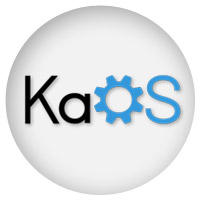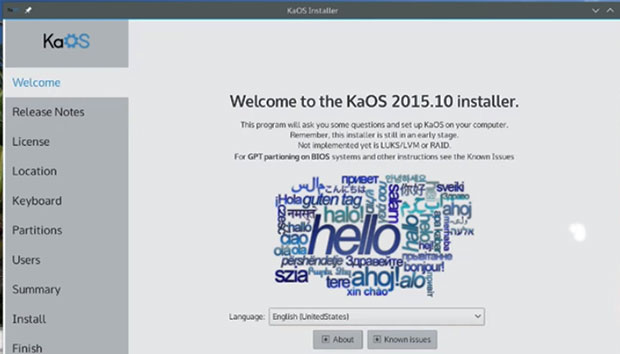
![]()
TheKaOS Linux distro is a very efficient Linux distribution built around a refined KDE desktop environment that just keeps getting better.
The KDE integration is much more controlled than you will find in other Linux choices. KaOS 2015.10 was released earlier this month. Welast reviewed this distro last year.
I was very impressed then with the solid performance of KaOS, and I liked how the community gave the KDE a tamer personality.
The latest version takes it one big step further, adding a very calming, cleaner look and feel to the user interface with KDE Plasma 5 as the default desktop.

Under the Hood
This release is a rolling distribution that updates the latest packages for the KDE Plasma Desktop. It includes significant features that make it well worth installing and has two major technology innovations.
The default XFS filesystem is CRC- and finobt-enabled. Having CRC enabled enhances error detection from hardware issues. The finobt format changes improve the crash recovery algorithms and beef up the ability of various tools to validate and repair metadata corruptions when they are found. This is something that other Linux distros do not yet provide.
Another innovation for KDE distros are changes to SDDM, kwin and kinit. These changes make it possible to start a Plasma Wayland session right from the login manager.
Wayland is a small display server protocol and interprocess communication library that replaces the X11 windowing system. The IPC shares data across multiple and commonly specialized processes using communication protocols.
An X11 session is still the default option, but the drop-down menu on the log-in screen now has a Wayland entry. The default Web browser, QupZilla, is one of the first applications that heavily relied on X11 in its code. That browser is now able to run a Wayland session as well.
Latest Advances
KaOS brought key upgrades for Linux in previous releases. The latest release goes further, widening the gap from other more typical Linux distros.
One essential difference with KaOS is that it is independent of other distros. Influenced by some Linux trends, yes, but controlled by another community’s decisions? No.
The KaOS community does not rely on repositories developed and maintained by larger Linux communities, so you’ll see little resemblance of package management systems and repositories such as those developed by Ubuntu, Arch or Red Hat. That doesn’t mean that the KaOS team sees something wrong with spin-offs from leading Linux families.
Marching Orders
KaOS’s development plan is more like the community wanting to have its own drum to beat with skins and sticks it made itself. At KaOS, it’s all part of putting out a uniquely independent product.
That is why KaOS maintains its own community-built packages. KaOS is built around a narrow set of software guidelines for software that runs on Qt, the guts of the KDE environment.
You won’t find that much attention to detail in other Linux distros that use the K Desktop Environment. KaOS has one of the best integrations of KDE and Qt that you’re likely to find in any Linux distribution.
Built With a But
The KaOS team is very particular about how it prunes software choices for inclusion in each release.
It offers just one flavor of Linux — the KDE option — coupled with a design decision early on about being very selective with the included software. The plan still is to include the best tools and applications for the KDE/Qt infrastructure.
Still, a few applications made their way into the KaOS repository. That was necessary because the QT (or non-GTK developer tools) option wasn’t the best fit for some applications, or there was a lack of Qt-based choices, according to the developers. You’ll find applications such as Inkscape and Ardour and some standard Web browsers included.
Software Supremacy
The KaOS developers maintain the community’s in-house repository. It has a simple yet well-planned structure. The KaOS repository has three groups: Core, Main and Apps. You can update to the latest collection of repository offerings with a complete system update done often. This is the beauty of a rolling release: Regular updates keep you up to date without having to reinstall the system.
The Core group has the base packages the system needs to boot, communicate with the BIOS, connect most hardware and set basic shell options. This repository group is carefully rolling. Any upstream update not thoroughly tested greatly affects the stability of the system.
The Main group in the repository consists of all the libraries, extra drivers and firmware to make the desktop and applications function. Many of these are fully rolling and move to the end user after seven to 10 days of testing. Some more vulnerable packages enter after enough upstream feedback is vetted, so no regressions occur.
The Apps group has all the software packages users load to get their computing tasks done. It is fully rolling and undergoes a brief testing period. Some application updates are put on hold if they depend on newer versions of Core or Main packages not yet fully tested.
This kind of attention to detail makes KaOS a one-of-a-kind computing platform. Most Linux distros are not rolling. The few that are do not provide the homegrown repository support that KaOS offers. I like this independent characteristic; it lets me use Linux with a higher level of satisfaction.
Moving In
I was pleasantly surprised with the look and feel of this latest release. KDE is one of the most configurable and user-centric environments in Linux Land.

KaOS’s integration of the K Desktop extracts power and productivity while keeping distractions out of sight. Two things make KaOS an outstanding Linux distro choice: Beginners find it easy to use, and advanced users can customize the environment to their hearts’ content.
You can put a litany of desklets and widgets on any of the virtual desktops, fill one or more panel bars with a variety of applets, and customize menus and special effects more than is possible in any other Linux desktop environment.
Using It
For example, right-click anywhere on the desktop. A single, short, simple menu opens at the mouse point to give you access to widgets, panels and activities controls. You can access the standard full-featured menu by clicking the menu icon at the far left edge of the panel bar at the bottom of the screen.
Virtual desktops are plain and simple to set up and use. You configure these in the Workspace section of the System Settings panel from the main menu rather than from panel settings menu.
I particularly like how the workspace switcher applet is integrated to the bottom panel. This is much handier than the procedure in GNOME or other KDE iterations.
The most confusing feature in KDE for me elsewhere has been the Activities panels that impose another layer of complexity to the desktop view. This is mostly gone in KaOS.
You won’t find the cumbersome hot spot in the upper right corner of the screen to activate the Activities display. Instead, just click on a small icon in the left screen corner. That pops open the Activities panel in the lower portion of the screen.
Bottom Line
KaOS has a few known issues, but these mostly affect specific hardware configurations. For example, to use a GUID Partition Table, or GPT, on a BIOS system, make sure you set it up following a guide available on the KaOS website. The installer’s partitioner can only handle GPT correctly for the Unified Extensible Firmware Interface.
In case you are curious, GPT is a partitioning scheme associated with the UEFI specification. It uses a unique identifier for qualifying devices. The process is the next-generation partitioning scheme to replace the Master Boot Record partitioning scheme method. For UEFI installs, KaOS uses systemd as the bootloader.
Another drawback is the lack of support for Redundant Array of Independent Disks, which is used as a data storage virtualization technology; Logical Volume Management disk partitioning technology; and Linux Unified Key Setup disk-encryption specification. KaOS does not install on those hardware items.
Installation is otherwise fairly straightforward. That said, KaOS’s ISOs do not support UNetbootin. Be sure to burn the and DVD at a burn speed no higher than 4x.
Want to Suggest a Review?
Is there a Linux software application or distro you’d like to suggest for review? Something you love or would like to get to know?
Please email your ideas to me, and I’ll consider them for a future Linux Picks and Pans column.
And use the Talkback feature below to add your comments!






















































